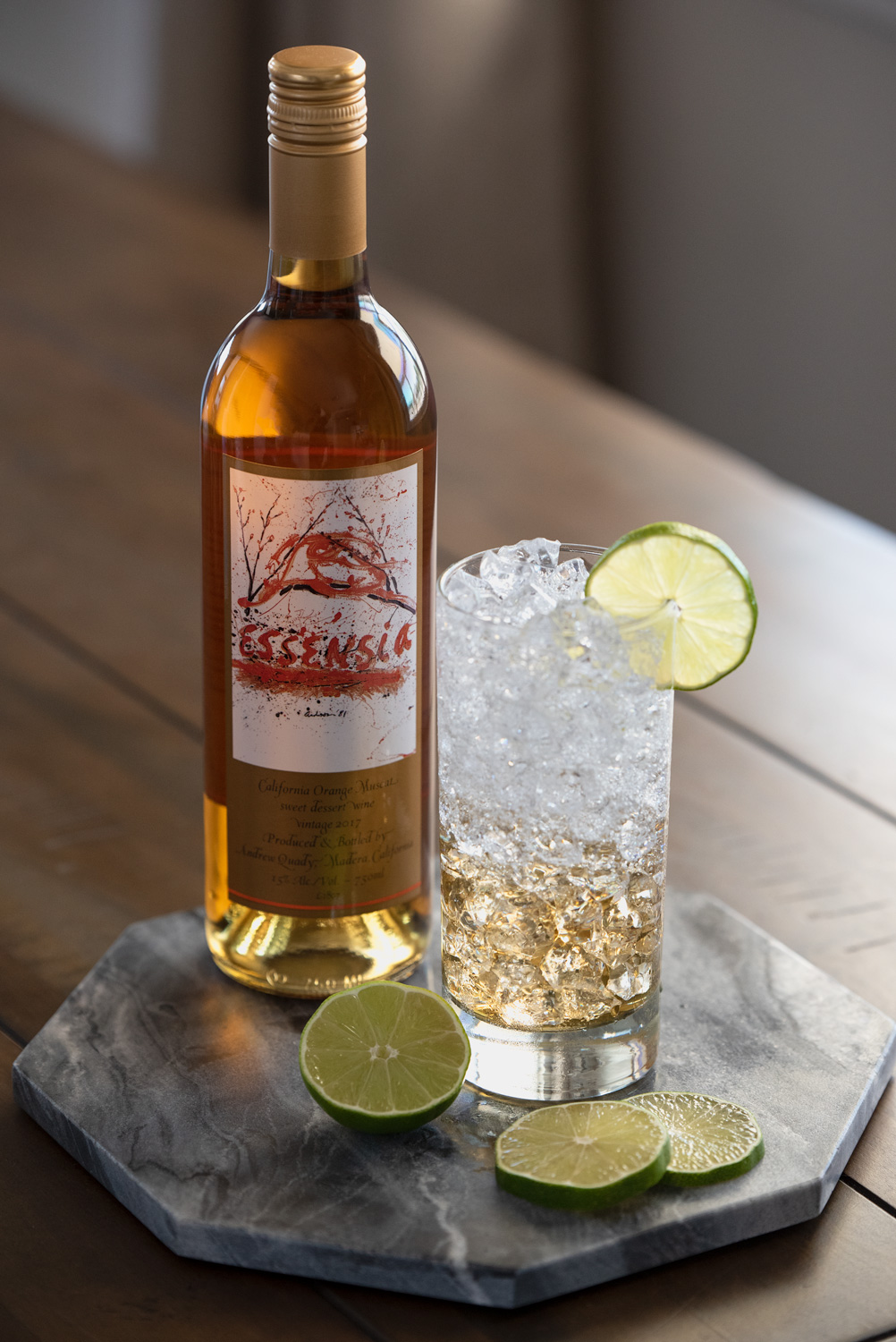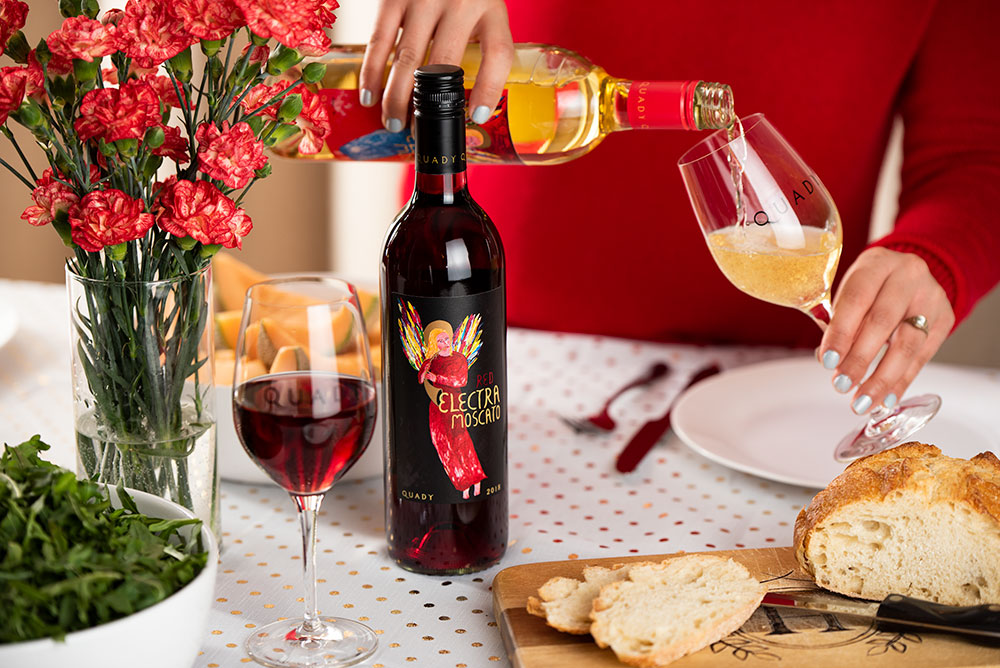Why We Make the Wines We Make
By Andy Quady
According to Wines Vines Analytics, California has more than 4,700 wineries. How many specialize in low-alcohol, sweet wines like Electra? Just one … Quady! How did this happen? Three things: attitude, opportunity and education.
Early in life, I acquired a risk-taking attitude. Then I got lucky and married a woman who had no problem with this, and supported me when I left one field of work and decided to re-educate myself in the specialty of winemaking (converting grapes into wine). To better support our new venture, she too re-educated herself – as a CPA – and went on to start her own successful practice. I was also fortunate when I inherited $50,000, because it came in handy when a good friend, Darryl Corti – a virtual “wine encyclopedia” and owner of an upscale grocery store in Sacramento – asked me to make a California Vintage Port from some old Zinfandel vines up in Amador County. That was in 1975.
I made 1,600 cases because the smallest tank in the winery I was working at held around 30,000 gallons, but Darryl only needed a few hundred cases. And that’s how I got into the Port business. We moved to Madera for my new job at United Vintners and I later started fielding phone calls from others who also wanted to distribute my Port. So then I needed a way to make more. In fact, I needed a winery. Amazingly, one of my colleagues had “bonded” his carport for winemaking, and his home, carport and 4 acres happened to be for sale. We invested my inheritance in a down payment on the property, a little winery, new tanks, and used equipment. We then secured a loan from the bank to buy grapes, and made 8,000 gallons of Zinfandel Port on evenings and weekends. By 1979, our enthusiastic production had outstripped our sales.

We started to consider adding a white fortified wine to diversify our range when the local farm advisor introduced us to the new owners of a large vineyard south of Fresno. The Christian Brothers had planted hundreds of acres of Muscat Canelli to use in their sweet Chateau La Salle wine, and hidden in the middle were 10 acres of Orange Muscat planted as a test plot. So in 1980, we bought enough Orange Muscat to make 300 cases of sweet Muscat wine.
This was our big break. I could tell these grapes were unique in their flavor and aroma, and that I was about to come up with a completely new kind of wine. My idea for these grapes was informed by the compilation of my education from UC Davis in winemaking, nine years of tasting wines from around the world, and an enophile’s honeymoon to France and Germany with my wife, where we’d immersed ourselves in wine and food culture. To back it up, I also have a degree in chemical engineering, which I knew was going to further support this innovative formulation. I felt pretty excited to use my education and life experiences to stretch outside the bounds of current U.S. winemaking practices!
The Orange Muscat grapes were handpicked into bins and sent to a cold-storage facility until I could spare the time from my responsibilities at United Vintners. After several weeks in cold storage, they were crushed, allowed to macerate on the skins, pressed, and allowed to start fermentation. We stabilized the wine at 15% alcohol (similar to practices in Europe, but not used here at the time). The wine spent two months in used oak barrels.
We named the new wine “Essensia” because our maceration technique captured the “essence” of the grape: the flavors, aromas and other phenolics. Essensia is deep gold with aromatics of orange blossom and apricot, a rich, long finish, and a clean, fruity aftertaste.

At this same time, the wine culture in America was changing. In 1971, Alice Waters founded the restaurant Chez Panisse in Berkley, California, dedicated to organic and flavorful heirloom produce. The term “California Cuisine” was being used to describe lighter food and a healthier style of eating that emphasized freshness. There became an increased emphasis on food and wine pairing. Essensia was released in 1981, the same year that Julia Child, Robert Mondavi, and Richard Graff founded the American Institute of Wine and Food. Essensia began to appear on dessert wine lists, and among them was that of Chez Panisse. In 1984, we released another sweet Muscat wine, Elysium, from the rose-scented Muscat Hamburg variety. Elysium pairs with chocolates and cheeses (especially blues). We held dessert contests with chefs across the U.S. to celebrate the rich flavors of our wines, challenging them to come up with the perfect pairings. The winners came on backcountry trail rides and went fly fishing with our family in the Sierra Nevadas.
In the late 1980s, we wondered what would happen if we attempted to make a low-alcohol wine, similar to the wines we’d tasted from Asti in Northern Italy (Moscato d’Asti). Thus, the first Quady Electra Moscato with only 4.5% alcohol was made in 1990; the alcohol was so low, we didn’t have to get label approval from the government. This wine, once we paired it with an exciting and colorful label painted by Ardison Phillips depicting an angel in flight, struck a chord with a broader market. It was light, fresh and aromatic – and swaths of consumers gravitated to it. It seems they had been waiting for a high quality, low-alcohol sweet wine to enjoy!
Low alcohol doesn’t mean that Electra Moscato is easy to make. On the contrary, it requires careful monitoring, refrigeration and filtration practices because you can’t count on the alcohol to kill the yeast. We harvest grapes destined for Electra Moscato at night, crushing in the wee hours to avoid accidental fermentation; then we immediately chill them, and keep them cold during the entire winemaking process. It is an exciting wine to make, and it is an art to get it right each and every time. Our winemaking team – headed by Darin Peterson – does a phenomenal job processing these wines, especially when you consider the rate at which we’ve been growing.

We’ve never considered adding any fruit to our wines other than Muscat grapes. There are many blueberry, peach, etc., sweet wines out there, so why wouldn’t we try this with Quady wines? The answer is simple: we can, and do, make better wine. (We’re up to 170,000 cases this year.) With our winemaking practices and the Muscat varieties we use, we get the aromas and flavors our customers prefer.
Electra Moscato, including Red Electra Moscato (introduced in 2000), make up more than 90% of our sales. Trying to keep up with demand while producing unparalleled quality is the new story of our business. My focus, aided by Assistant Winemaker Cole Denis, has been managing the expansion of our facilities. Our winemaking, sales, and administrative teams have had to handle a thousand curve balls, and not a few mistakes. Our Production Manager, Dan Mejia, bottled more wine than we have ever bottled before, amidst a pandemic. Our National Sales and Marketing Director, Jim Fricke, continues to set us up for success in markets across the U.S. despite our constraints. Our IT and Business Manager, Dave Glover, is the glue that holds us all together. Thankfully, our employees are still showing up to tackle the opportunities and challenges in front of us. I am so proud of them.
Our plan is to continue to meet market demand in coming years and to finally give some more attention to Vya Vermouth, which is another exciting story for another newsletter. Stay tuned.

